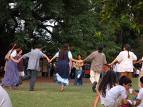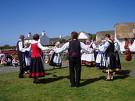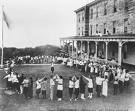|
REALTalk is about how we communicate with ourselves, it's about being very clear about our priorities so the things we do every day end up creating the life we want. Beyond that, it is a tool we can use to communicate with others ~ a way to let them know what we are about, to hear what they are about, and to come up with strategies that please both/all of us. So, what's dance got to do with that?

Before we can dance with others, we first have to feel the music in our own body! Yet, when it comes to our every day interactions with others (the dance of life) many of us communicate with others without first being in touch with ourselves. Dancing with Marshall Retreats start with our inner world and provide support for making peace and clarity in ourselves before we reach out to others. Because dancing is movement, it helps us learn faster and bring our body along with what our mind is learning (body/mind integration)1.
The hippocampus area of the brain births as many as 60,000 new nerve cells every day2. Active exercise is necessary for these new cells to form and remain healthy. The hippocampus is where many new memories are formed. So, when we want to change our behavior or learn something new, active movement is our best friend.
"Thinking itself is actually a skill dependent upon the whole, integrated body/mind system. The whole system must be active in order to take in information, select what is important about the information, integrate it with existing patterns, and finally, to anchor it. Thinking and learning are anchored by movement."3
Dance encourages our body to let go of tension. When we are relaxed and having fun, we learn new information more quickly4. We remember it when it's associated with emotion5; music, rhythm, and movement stir emotion. Dance is important to facilitators because it makes learning more efficient. It is important to participators because it makes learning more fun.

Learning to dance, according to Laura Shannon6, asks us to travel the same pathway as we have discovered that learning REALTalk asks of us. First, we are introduced to the mechanics and we spend a little time getting familiar with the steps. During this stage, we can often feel impatient and eager to become more proficient. Uniquely, this retreat introduces the mechanics as they apply to our inner self-talk rather than how we speak to others.
As the steps become more natural and our body and brain begin to automatically remember what to do next; our energy is freed up to begin to notice our own internal experience as we move through the steps. We start "feeling" the steps and having insights about ourselves and how we relate to space and others.
It is only after we've fully experienced these first two phases, that we are truly available to dance with others. Before we have the mechanics down, our energy is consumed in just trying to remember where to put our feet and how to relate all the parts of our bodies in response to the music and the particular dance we're doing (if there is a structure to the dance). Then, as we become more facile, we become more fully alive to the energy of the dance and we're often self-absorbed as we explore our internal world with a new found wonder. Finally, we are ready to share the space with another. We begin to notice ourselves in relationships to the other dancers. We begin to connect to their experience, as well as our own.
And, this third phase brings new challenges and opportunities ~ in interacting with another while the our feet are moving, and our internal world is fully alive. Now, we integrate our awareness of what another person is doing and decide how we want to relate to this.
So it is with REALTalk; we move through the same three phases. The medium of dancing seems particularly appealing as we learn to apply REALTalk, because of the emphasis on the middle step of learning, where we tune in to our inner experience. Combining dancing with REALTalk keeps this focus on our inner experience very much alive.
  
Dance is a powerful personal learning and healing tool in its own right. It asks openness of us, it provides an avenue for expression, and it cultivates internal balance. It is also a tool for connecting with others. It reminds us of how universal our needs are, intensifying bonds of shared experience and common values.
Village Dance is particularly suited to partner with REALTalk. Village Dance is done in a circle, so each individual is clearly part of a larger community. Each person takes personal responsibility for learning and making their own moves, and yet they are in partnership with everyone else in the circle.
   
We'd like to tell you that we carefully researched all the possible combinations and chose the one that is the most effective. But, that's not what happened. The real story is that I met Kayla at a practice group where people were learning how to use nonviolent communication. I had been developing RealTalk and cherishing a dream of bringing movement into the workshops; this idea sparked Kayla who was interested in engaging people in dance through any avenue open to her. As we began to explore the possible combination of our two artforms, Kayla and I realized that we had stumbled upon what has turned out to be the perfect combination.
Kayla has devoted her life to a form of circle dance that we call Village Dance because it is derived from traditional dances that were usually done in village squares throughout all phases of history the world over. They were used to celebrate and mourn; as a form of expression for what was going on in the village. Dancing was a way for the people to come together as a community and share their common experience of life.
Putting dance together with REALTalk creates a powerful elixir of artforms that we use as tools. We are delighted to bring this combination to you ~ putting our focus on communicating more powerfully with ourselves, and securing our growth with the dynamic glue of movement through dance.

References:
1Movement supports learning. Hannaford, Carla Smart Moves p 110
2The hippocampus creates up to 60,000 new nerve cells daily. Ericksson, Peter S., Fred H. Gage, et. al. 1998. Neurogenesis in the Adult Huma Hippocampus. In: Naure Medicine, 4 (11), 1313-1317, November
3 Hannaford, Carla Smart Moves p 99
MacLean, Paul D. The Triune Brain in Evolution, Role in Paleocerebral Functions. NY: Plenum Press, 1990. pp. 559-60
Sylvester, Robert. Unconscious Emotions, Conscious Feelings and Curricular Challenges. Educational Leadership Journal. November 2000).
4Information intake is handicapped unless we feel safe. Siegel and Hartzell, Parenting from the Inside Out
Marano, Hara Estroff. 1999. Depression: Beyond Serotonin. Psychology Today, March/April 1999. pp. 33-34
Ibid. pp. 72-73.
5Emotion anchors memories. LeDoux, Joseph The Emotional Brain: The Mysterious Underpinnings of Emotional Life NY, Touchstone Books, 1996
6Laura Shannon, keeper and trainer of traditional circle dances. http://www.laurashannon.net
 
Related Resources: Dr. Stuart Brown and The National Institute for Play
Serious Play: A Game for Businesses, A book, The 2008 Art Center Design Conference
The Creative Brain by Ned Hermann
|











